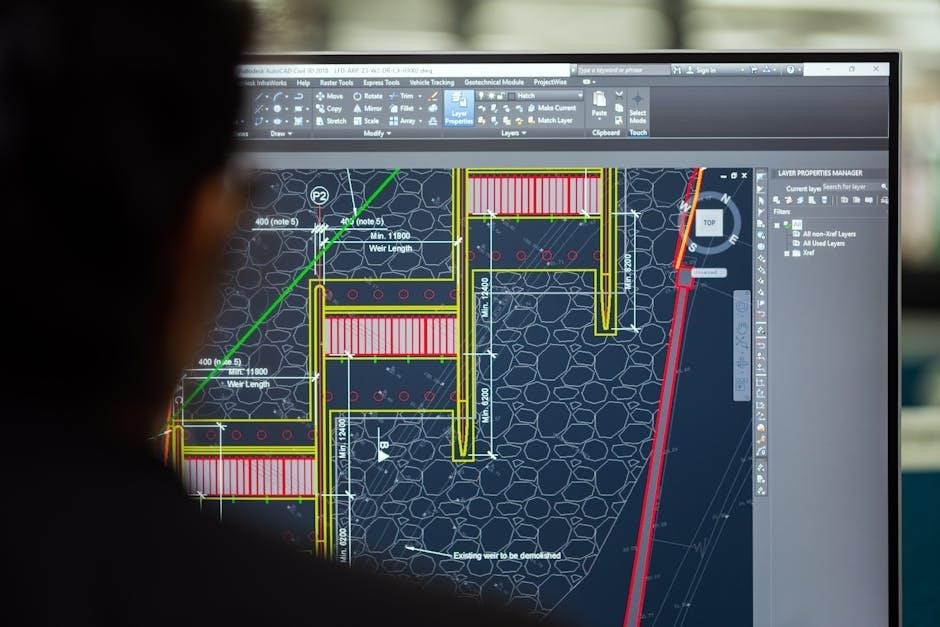Discover the strategies and techniques from Donald Trump’s The Art of the Deal, offering insights into negotiation, confidence, and leveraging power to achieve success.
Overview of Donald Trump’s Negotiation Philosophy
Donald Trump’s negotiation philosophy, as outlined in Nghệ thuật đàm phán Trump PDF, revolves around confidence, strategic preparation, and emotional intelligence. He emphasizes the importance of leverage, understanding the counterparty’s needs, and maintaining a strong position. Trump advocates for assertiveness, creativity, and the ability to adapt during negotiations. His approach often involves building relationships while remaining firm on objectives. This philosophy blends traditional business tactics with a modern, unconventional style, reflecting Trump’s experience in real estate, politics, and entrepreneurship. His methods have been both praised for their effectiveness and criticized for their aggressiveness.
Key Themes in “The Art of the Deal”
In Nghệ thuật đàm phán Trump PDF, Donald Trump highlights key themes such as confidence, leverage, and emotional intelligence. He stresses the importance of understanding the counterparty’s motivations and maintaining a strong, assertive stance. The book emphasizes strategic planning, adaptability, and the power of relationships in negotiations. Trump also underscores the value of thinking creatively and being willing to walk away when necessary. These principles, drawn from his real estate and business experiences, form the core of his negotiation philosophy, blending tradition with unconventional tactics to achieve success in high-stakes deals.
Why Trump’s Negotiation Style is Unique
Donald Trump’s negotiation style stands out due to its boldness and unpredictability. He combines assertiveness with a keen sense of emotional intelligence, often using psychological tactics to influence outcomes. Unlike traditional approaches, Trump’s methods emphasize creating a sense of urgency and leveraging media presence to gain an edge. His willingness to take risks and push boundaries sets him apart, making his strategies both controversial and effective in high-pressure situations. This unique blend of confidence and creativity has made his approach widely studied and debated in business and politics alike.

The Core Principles of Trump’s Negotiation Strategy
Trump’s negotiation strategy revolves around confidence, leverage, and emotional intelligence. He emphasizes creating a competitive edge through bold moves and strategic positioning to achieve advantageous outcomes.
The Importance of Confidence in Negotiations
Confidence is central to Trump’s negotiation approach, as it projects authority and credibility. A strong, self-assured demeanor intimidates opponents and creates a psychological edge. Trump believes confidence not only secures better deals but also builds trust and respect. By maintaining an unwavering stance, negotiators can influence outcomes in their favor. Confidence, according to Trump, is non-negotiable—it’s the cornerstone of successful deal-making, allowing individuals to assert their positions effectively and achieve their goals.
Using Leverage to Your Advantage
Trump emphasizes leveraging power dynamics to gain control in negotiations. Identifying and exploiting advantages, such as exclusive resources or information, creates a strategic edge. By maximizing bargaining power, negotiators can dictate terms and secure favorable outcomes. Trump advocates for assertively using leverage to pressure counterparts, ensuring they concede to your demands. This approach, while assertive, underscores the importance of maintaining control and being prepared to act decisively, reflecting Trump’s belief in the power of strategic leverage to achieve dominance in any deal.
The Role of Emotional Intelligence
Donald Trump underscores the significance of emotional intelligence in negotiations, emphasizing its role in understanding and influencing others. By recognizing emotions, one can tailor their approach to align with the interests of all parties involved. This ability not only fosters cooperation but also enhances one’s capacity to make informed decisions. Mastering emotional intelligence is essential for any aspiring negotiator aiming to adopt Trump’s negotiation strategies effectively in various business scenarios.

Preparation and Planning in Trump’s Negotiations
Trump’s success lies in meticulous preparation, understanding the counterparty, and setting clear objectives to create a strategic advantage in every deal.
Researching the Counterparty
Researching the counterparty is crucial in Trump’s negotiation strategy. Understanding their background, financials, and past deals helps identify strengths, weaknesses, and motivations. By analyzing their negotiation style and priorities, Trump gains a strategic edge. This thorough preparation allows him to tailor his approach, addressing their needs while asserting his goals. Leveraging publicly available data and insights ensures he enters discussions informed and ready to influence outcomes effectively.
Setting Clear Objectives
Setting clear objectives is vital in Trump’s negotiation approach. Having a well-defined vision ensures focus and direction. Priorities must be established, and desired outcomes should be specific, measurable, and achievable. Trump emphasizes knowing exactly what you want to achieve, allowing for precise communication and unwavering pursuit of goals. Flexibility is key, but objectives remain non-negotiable. This clarity enables effective decision-making and maintains momentum, driving discussions toward favorable results aligned with your interests.
Anticipating the Opponent’s Moves
Trump’s negotiation strategy heavily relies on anticipating the opponent’s moves. Understanding their priorities, strengths, and weaknesses allows for proactive planning. By predicting their strategies, you can prepare countermeasures and maintain control. Flexibility is key, as scenarios evolve, but foresight ensures you stay one step ahead. This approach minimizes surprises and maximizes leverage, keeping negotiations aligned with your goals. Anticipating opportunities and challenges enables effective adjustments, ensuring a strategic advantage in achieving desired outcomes.

Psychological Tactics in Trump’s Deal-Making
Trump employs psychological tactics to influence negotiations, using persuasion, emotional manipulation, and strategic positioning to sway outcomes in his favor, maintaining power throughout the process effectively.
Reading the Opponent’s Body Language
Trump emphasizes the importance of interpreting body language to gauge an opponent’s intentions and emotions. By observing posture, eye contact, and facial expressions, he adapts his approach to exploit vulnerabilities, ensuring strategic dominance in negotiations. This skill allows him to anticipate reactions, making his deal-making process more intuitive and effective. Mastery of nonverbal cues has been a cornerstone of his negotiation success, enabling him to navigate complex interactions with confidence and precision.
Using Persuasion Techniques
Trump’s negotiation style heavily relies on persuasive techniques to influence outcomes. He uses storytelling, repetition, and emotional appeals to connect with counterparts, framing his arguments to align with their interests. By simplifying complex ideas and creating a sense of urgency, he effectively sways decisions in his favor. These methods, outlined in Nghệ thuật đàm phán Trump PDF, highlight his ability to turn conversations into opportunities, ensuring his objectives remain central to the negotiation process and fostering an environment conducive to agreement.
Creating a Sense of Urgency
Trump often employs time-sensitive strategies to accelerate negotiations, creating a sense of urgency to prompt quicker decisions. By setting tight deadlines or implying scarcity, he pressures counterparts to act swiftly, reducing the likelihood of prolonged debates. This tactic, as detailed in Nghệ thuật đàm phán Trump PDF, is designed to capitalize on immediate opportunities, ensuring favorable outcomes. His approach emphasizes the importance of timely action, often leading to advantageous deals in high-stakes negotiations.
Communication Strategies in Negotiations
Effective communication is vital in Trump’s negotiation approach, emphasizing clarity, persuasion, and active listening. His strategies include storytelling and straightforward messaging to influence outcomes and build rapport.
The Power of Direct and Clear Messaging
Donald Trump’s negotiation style emphasizes the importance of clear and direct communication. By avoiding ambiguity, he ensures all parties understand his position, reducing misunderstandings. This approach allows for focused discussions, enabling quicker resolutions. Clarity also projects confidence, making his messages more persuasive. Trump’s ability to articulate his goals succinctly has been key in his business and political dealings. His directness often disarms opponents, creating an environment where his terms are more likely to prevail. This strategy highlights how precision in communication can be a powerful tool in achieving negotiation success.
Active Listening Skills
Active listening is a cornerstone of Trump’s negotiation tactics, allowing him to understand opponents’ needs and tailor his approach accordingly. By attentively listening, he identifies key concerns and leverages them to his advantage. This skill helps build rapport and fosters an environment of mutual understanding. Trump’s ability to listen actively enables him to adapt his strategy mid-negotiation, ensuring he remains aligned with the counterparty’s interests while advancing his own goals. This approach not only enhances his persuasiveness but also strengthens long-term relationships, making him a formidable negotiator in both business and politics.
Using Storytelling to Influence
Trump masterfully employs storytelling to captivate audiences and sway negotiations in his favor. By sharing relatable anecdotes, he simplifies complex ideas and creates emotional connections. His ability to craft compelling narratives makes his arguments memorable and impactful. Storytelling allows Trump to frame situations strategically, highlighting strengths and minimizing weaknesses. This technique not only engages counterparts but also builds trust, making his propositions more appealing. Through storytelling, Trump transforms negotiation into a persuasive art form, leveraging the power of narrative to achieve his objectives effectively.

Handling Conflict and Disagreements
Trump excels at managing conflicts with calm assertiveness, turning disagreements into opportunities. His approach emphasizes strength, ensuring conflicts are resolved in his favor while maintaining control.
Remaining Calm Under Pressure
Trump’s ability to remain calm under pressure is a cornerstone of his negotiation style. He emphasizes the importance of emotional control, ensuring decisions are made rationally rather than impulsively. By staying composed, Trump maintains clarity and focus, allowing him to navigate high-stakes situations effectively. His confidence and preparation enable him to handle pressure with ease, turning potential challenges into opportunities. This calm demeanor not only projects strength but also instills confidence in his negotiation counterparts, giving him a strategic advantage in achieving his objectives.
Knowing When to Walk Away
Walking away is a strategic tactic Trump uses to maintain power in negotiations. He believes that knowing when to step back prevents settling for unfavorable terms and demonstrates confidence. This approach creates urgency for the other party to reconsider, often leading to more favorable outcomes. Trump views walking away not as a defeat but as a calculated move to avoid being taken advantage of, showcasing his ability to prioritize self-respect and long-term goals over immediate gains. This tactic reinforces his reputation as a shrewd and deliberate negotiator.
Turning Confrontation into Opportunity
Trump excels at transforming confrontations into opportunities by maintaining calm and assertiveness. He views conflicts as chances to renegotiate terms or gain leverage. By staying composed, he projects strength, often forcing opponents to reconsider their positions. This tactic allows him to pivot tense situations into favorable outcomes, demonstrating his ability to thrive under pressure. Trump’s approach emphasizes turning challenges into advantages, showcasing his resilience and negotiation prowess. This strategy underscores his belief in using every interaction, even contentious ones, to achieve his objectives effectively.

The Role of Relationships in Negotiations
Trump emphasizes building strong relationships to foster trust and collaboration, leveraging personal connections to secure advantageous deals and long-term partnerships.
Building Rapport with the Counterparty
Trump highlights the importance of establishing a personal connection with the counterparty to create a foundation of trust and mutual understanding. By demonstrating confidence and emotional intelligence, he fosters a collaborative environment. Active listening and showing genuine interest in the opponent’s perspective help build rapport. Trump often uses storytelling and shared experiences to create a sense of camaraderie, making negotiations more productive. This approach not only eases tensions but also encourages creative solutions, ultimately benefiting both parties. Building rapport is a cornerstone of Trump’s negotiation strategy, enabling him to turn adversaries into allies.
Maintaining Long-Term Partnerships
Trump emphasizes the importance of trust and mutual respect in sustaining long-term partnerships. By aligning interests and ensuring both parties benefit, he fosters loyalty and collaboration. Regular communication and delivering on commitments are key to maintaining these relationships. Trump also highlights the value of flexibility, adapting to changing circumstances while remaining true to shared goals. Long-term partnerships, built on trust and reliability, are integral to his business philosophy, ensuring stability and future opportunities. This approach not only strengthens professional bonds but also creates a foundation for enduring success in any industry.
Networking for Future Deals
Trump’s approach to networking revolves around building relationships that open doors to future opportunities. By attending high-profile events and engaging with influential figures, he expands his network. Trump stresses the importance of following up after meetings, ensuring connections remain strong. He also leverages social media to maintain visibility and reach a broader audience. Effective networking, in Trump’s view, is about creating mutually beneficial relationships and staying proactive in pursuit of new deals. This strategy fosters trust and credibility, laying the groundwork for successful collaborations and long-term business growth.

Case Studies of Trump’s Successful Negotiations
Explore Trump’s renowned deals, such as the Grand Hyatt renovation and Trump Tower development, showcasing his negotiation tactics and ability to transform high-stakes opportunities into success.
Real Estate Deals
Trump’s real estate negotiations exemplify his mastery of deal-making. The transformation of the Grand Hyatt and the acquisition of Trump Tower highlight his ability to leverage opportunities. By negotiating favorable terms and employing creative financing strategies, Trump turned these projects into iconic successes. His approach often involved confident risk-taking and a relentless pursuit of advantageous terms. These deals not only solidified his reputation in real estate but also showcased his ability to navigate complex negotiations with precision and flair, leaving lasting lessons for aspiring negotiators in the industry.
Business Partnerships
Trump’s negotiation tactics in business partnerships highlight his ability to create mutually beneficial agreements. By leveraging his brand and reputation, he often secured favorable terms, ensuring profitability. His approach emphasized building relationships while maintaining control. For instance, licensing deals allowed Trump to expand his brand’s reach without significant financial risk. These partnerships demonstrate how strategic negotiations can maximize value, offering lessons in balancing collaboration with assertiveness. Trump’s ability to align with strong partners while protecting his interests underscores his pragmatic approach to deal-making, making his strategies a valuable study for business professionals seeking to enhance their negotiation skills.
Political Negotiations
Trump’s political negotiations reflect his unconventional tactics, blending assertiveness with strategic communication. During his presidency, he renegotiated trade deals like NAFTA and engaged in diplomatic talks with North Korea. His approach often involved setting clear objectives and using media to influence public perception. Critics argue his methods were divisive, yet supporters praise his ability to disrupt traditional diplomacy. These negotiations demonstrate Trump’s willingness to challenge norms, offering insights into the intersection of politics and deal-making. His strategies, though controversial, provide lessons in navigating complex power dynamics and leveraging media in high-stakes negotiations.

Criticisms and Controversies Surrounding Trump’s Approach
Trump’s negotiation style faces criticism for its aggressive tactics and ethical concerns. Critics argue his methods prioritize short-term gains over long-term relationships, raising questions about sustainability and trust.
Aggressive Tactics
Trump’s negotiation style is often criticized for its aggressive nature, with critics arguing that his confrontational approach can damage relationships and foster distrust. His willingness to walk away from deals, use divisive language, and apply pressure tactics has sparked controversy. While some view these methods as effective in securing short-term gains, others believe they undermine long-term partnerships and ethical standards. This bold strategy, as outlined in Nghệ thuật đàm phán Trump PDF, reflects his belief in asserting dominance but raises concerns about its broader implications in business and diplomacy.
Short-Term vs. Long-Term Success
Trump’s negotiation approach often prioritizes short-term gains, which can lead to immediate success but may compromise long-term relationships. Critics argue that his strategies, while effective in securing quick wins, can hinder sustained growth and trust. The emphasis on immediate results may overlook the importance of fostering lasting partnerships, potentially harming future collaborations. However, supporters claim that his methods can reset expectations and create new opportunities. This debate highlights the tension between achieving rapid victories and building enduring success, a key consideration in evaluating Trump’s negotiation legacy. Balancing these aspects remains a critical challenge.
Ethical Concerns
Donald Trump’s negotiation tactics have raised ethical concerns, particularly regarding transparency and fairness. Critics argue that his aggressive strategies, such as bending truths or exploiting weaknesses, can undermine trust and integrity. The focus on winning at all costs may lead to unethical compromises, prioritizing personal gain over mutual benefit. Additionally, his approach often disregards long-term reputational damage for short-term advantages. These practices have sparked debates about the morality of his methods, questioning whether success should come at the expense of ethical principles. Balancing ambition with integrity remains a key issue in evaluating Trump’s negotiation legacy. His tactics challenge traditional ethical standards in business and politics.

Lessons Learned from Trump’s Negotiation Style
Trump’s style emphasizes confidence, emotional intelligence, and adaptability. His approach highlights the importance of preparation and leveraging unique opportunities, offering valuable insights for modern negotiators seeking success.
Adaptability in Negotiations
Adaptability is crucial in Trump’s negotiation style, as he often adjusts strategies mid-deal. His ability to read situations and pivot when necessary sets him apart. Trump’s experience in diverse industries, from real estate to entertainment, has honed his skill in tailoring approaches to different scenarios. He emphasizes flexibility, urging negotiators to remain open to new information and willing to change course. This adaptability allows him to exploit opportunities others might miss, making his negotiation style both dynamic and effective in unpredictable environments.
Thinking Outside the Box
Trump’s negotiation philosophy thrives on unconventional thinking. He often challenges traditional methods, advocating for creative solutions to complex problems. By thinking outside the box, Trump identifies unique opportunities and presents innovative proposals that catch counterparts off guard. This approach not only sets him apart but also allows him to redefine deal terms in his favor. His willingness to explore uncharted territory has led to groundbreaking agreements, proving that innovation can be a powerful tool in achieving success.
Understanding the Power of Branding
Branding is a cornerstone of Trump’s negotiation strategy, as highlighted in Nghệ thuật đàm phán Trump PDF. He emphasizes the importance of creating a strong, recognizable brand to establish credibility and trust. A powerful brand not only commands respect but also provides leverage in negotiations. Trump’s personal brand, for instance, symbolizes success and authority, allowing him to influence decisions and secure favorable terms. This approach underscores how effective branding can transform perceptions and empower negotiators to achieve their objectives more effectively.

Applying Trump’s Strategies in Modern Business
Trump’s negotiation tactics, such as confidence and leveraging power, remain relevant in modern business. However, adapting these strategies to emphasize collaboration and ethical practices ensures sustainable success.
Adapting Tactics for Different Industries
Trump’s negotiation strategies can be tailored to various industries by understanding their unique dynamics. For instance, in tech, confidence and emotional intelligence are key, while in real estate, leveraging relationships and creating urgency drives success. In finance, maintaining calm under pressure and anticipating counterparty moves are crucial. By adapting these tactics, businesses can enhance their negotiation outcomes. However, ethical considerations and long-term partnerships must also be prioritized to ensure sustainable growth across industries.
Using Social Media for Negotiation
Social media has emerged as a powerful tool in modern negotiation, influenced by Trump’s strategies. Platforms like Twitter and LinkedIn allow direct communication with stakeholders and can build personal branding. By leveraging social media, negotiators can create a sense of urgency, share persuasive content, and engage with broader audiences. However, ethical concerns arise, as aggressive tactics may harm long-term relationships. Balancing traditional methods with digital engagement is key to effective negotiation in today’s interconnected world.
Combining Traditional and Modern Methods
Trump’s approach highlights the effectiveness of blending traditional negotiation techniques with modern tools. While face-to-face meetings and personal charm remain essential, digital platforms now amplify these efforts. Emotional intelligence and strategic leverage still form the backbone of negotiations, but modern methods like social media engagement and data-driven insights enhance their execution. This fusion allows negotiators to adapt to evolving business landscapes while maintaining core principles. By merging timeless strategies with contemporary resources, professionals can achieve more dynamic and successful outcomes in today’s fast-paced environment.
“The Art of the Deal” encapsulates Trump’s negotiation philosophy, emphasizing confidence, strategic planning, and adaptability. These principles remain relevant in today’s competitive business environment, offering valuable insights for modern negotiators aiming to succeed.
Final Thoughts on Trump’s Negotiation Philosophy
Donald Trump’s negotiation philosophy, as outlined in The Art of the Deal, revolves around confidence, calculated risk-taking, and leveraging power. His approach emphasizes the importance of understanding human nature and staying adaptable. While his methods can be polarizing, they offer unique insights into deal-making. By combining assertiveness with strategic planning, Trump’s philosophy encourages negotiators to think creatively and assertively, making it a valuable resource for those seeking to refine their negotiation skills in both personal and professional settings.
Key Takeaways for Aspiring Negotiators
Aspiring negotiators can learn from Trump’s emphasis on confidence, leveraging power, and emotional intelligence. Preparation and adaptability are crucial, as is understanding the counterparty’s needs. Building relationships and maintaining a strong brand presence can enhance negotiation outcomes. While his assertive style may not suit everyone, the principles of persistence, creativity, and strategic thinking are universal. By mastering these elements, negotiators can refine their skills and achieve more favorable deals in various professional and personal contexts.
The Future of Negotiation Tactics
The future of negotiation tactics will likely blend traditional methods with modern tools like AI and social media. Trump’s strategies highlight the importance of adaptability, emotional intelligence, and leveraging data for informed decisions. As global interactions increase, cross-cultural understanding and ethical considerations will become pivotal. The integration of technology, such as predictive analytics, will enhance preparation and execution. Meanwhile, the ability to balance assertiveness with empathy will define successful negotiators in a rapidly evolving world, ensuring long-term partnerships and mutual benefits.